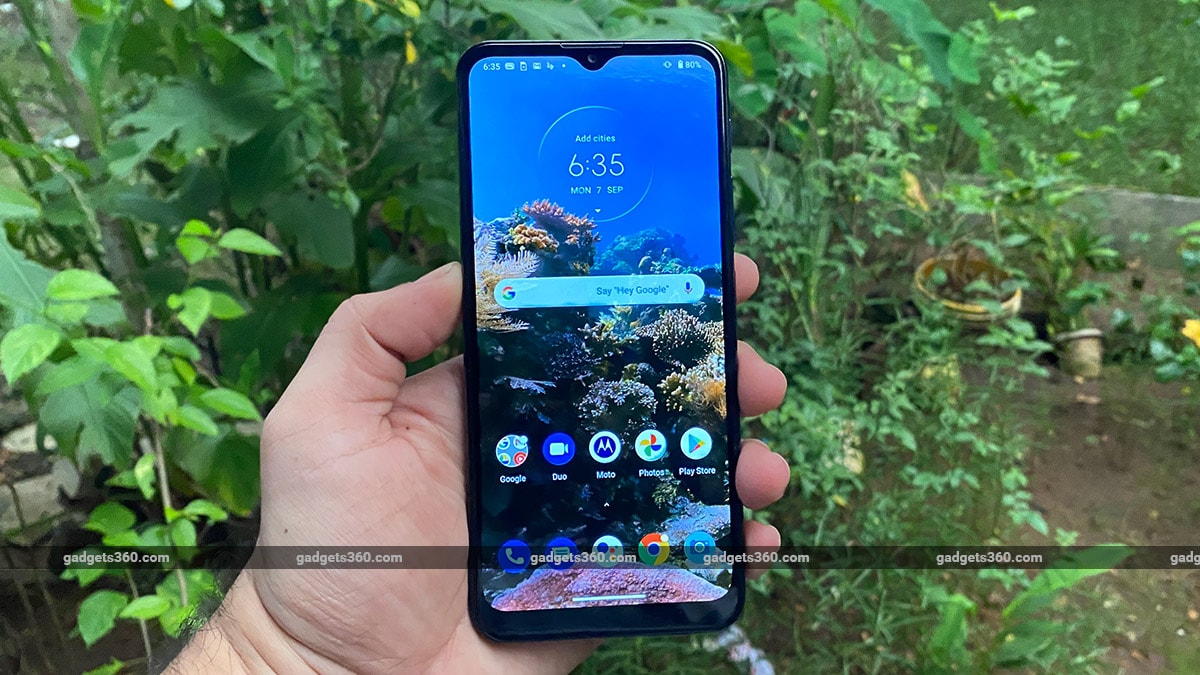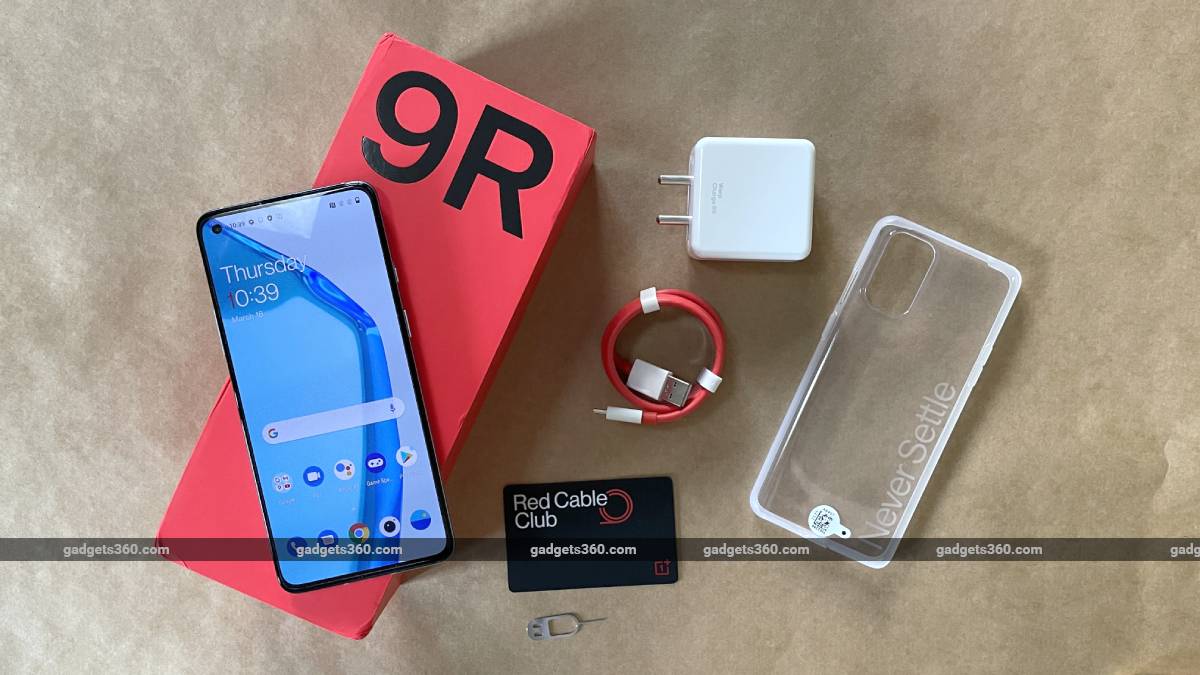The Moto G series has been the backbone of the Motorola lineup in India for a while now, and helped the brand reestablish its position in the budget segment. Lately though, this series was overshadowed with the One Series from Motorola, and the last few models have not made huge marks. In order to bring the Moto G series back into the limelight, Motorola has brought the Moto G9 to India, and we are the first market to get this new smartphone. So has Motorola designed this phone well enough to face its fierce competition? I review the Moto G9 to find out.
Moto G9 Design: Tall and shiny
I already spent some time with the Motorola Moto G9 at the time of its launch and you can read my first impressions of the device. The Moto G9 has a big 6.5-inch IPS LCD panel with an HD+ resolution and tall 20:9 aspect ratio which is great for watching content on, in landscape mode. However, reaching the top of the display isn’t easy when using this phone single-handed, and requires a quick shuffle in the hand. Motorola has kept the bezels slim on the sides but the chin is thicker. We’re now seeing more and more smartphones with hole-punch displays in the budget segment, but Motorola has stuck with a more traditional dewdrop notch to house the selfie camera.
Pick this phone up and you will notice that it measures over 9mm in thickness. The sides are squared but they curve into the back giving you a good grip on the device. Motorola has packed in a 5,000mAh battery,and so the Moto G9 tips the scales at 200g. You will notice the weight after using this smartphone for a while.
![]()
The Moto G9 is offered in flashy colour options
Motorola has added a dedicated Google Assistant button which is a neat touch, but the placement could have been better. It is on the upper right side of the device and isn’t reachable very easily while holding it. The power and volume buttons on the Moto G9 are also on the right, so that’s four in total. The left only has a SIM tray. Motorola could have put the Google Assistant button on the left side, just like it is positioned on the Nokia 5.3 (Review), which I tested recently.
With the Moto G9, the company has opted for flashy colours, and so you get Sapphire Blue and Forest Green colour options. I had a Sapphire Blue unit for this review, and it grabs eyeballs very easily. It also has a gradient colour finish. The camera module is squarish and has three lenses plus the flash so you don’t have a separate cutout for that. Right below the camera module is the fingerprint scanner which has a matte finish and contrasts well with the glossy back. I found the fingerprint scanner to be well positioned.
Moto G9 Specifications and software: New SoC and near stock Android
The Motorola Moto G9 is the first smartphone in India to sport the Qualcomm Snapdragon 662 SoC. This is an octa-core processor built on an 11nm process with four cores clocked at 2GHz and the other four cores clocked at 1.8GHz. The performance cores run at a lower clock speed than those on the Snapdragon 665 SoC so it’ll be interesting to see the performance difference if there is any in the benchmarks.
The 6.5-inch display has an HD+ resolution, which isn’t the highest at this price point, and competitors at around the same price such as the Redmi Note 9 (Review) do feature full-HD+ displays. There’s a hybrid dual-SIM tray, so if you have two SIMs in the device, you won’t be able to expand storage, which could be a problem since the Moto G9 is only available in one configuration. You get 4GB of RAM and 64GB of storage, and it is priced at Rs. 11,499.
![]()
Motorola’s MyUX offers a near-stock Android experience with some useful features
Motorola offers MyUX on top of Android 10, which has very minor customisations. It feels as though you are using stock Android with a few useful features sprinkled on top. Moto Actions let you execute certain shortcuts using gestures. The Moto G9 uses swipe-based gesture navigation by default but you do get the option to switch to the traditional three-button layout if you aren’t comfortable with that.
I had the July Android Security patch on the review unit. Motorola has also included Moto Gametime which lets you block calls, notifications, and certain Moto actions while you are gaming, to prevent distractions. I like that Motorola has kept preinstalled apps to a minimum, and you only get Facebook preinstalled apart from some Google apps.
Moto G9 performance: Casual user’s delight
A new processor is always exciting to test, so I was curious to see how the Qualcomm Snapdragon 662 SoC performs. I did not face any lag while going through the menus and loading stock apps in the Android UI. I could also load multiple apps and multitask between them quite easily. However, loading heavier apps and games took noticeably longer.
I ran a couple of benchmarks to see how the Motorola Moto G9 fares compared to some of the other smartphones in the market. In PCMark Work 2.0 it scored 7,604 points which is higher than the Nokia 5.3 with its Snapdragon 665 SoC. I could not get AnTuTu to run on the Moto G9. In terms of graphics, this phone managed 49fps and 13fps in GFXBench’s T-Rex and Car Chase tests respectively. Another competitor, the Redmi Note 9 managed better CPU performance, but its graphics scores were weaker in benchmarks compared to the Moto G9, but that could be because of the difference in display reolutions between these phones.
![]()
The Moto G9 is capable of playing games such as Asphalt 9: Legends and Call of Duty Mobile
Battery life with the Moto G9 was good, and the phone lasted me about a day and a half with my usage. The high capacity battery does help the Moto G9 get an edge over the Nokia 5.3. In our HD video loop test, the smartphone managed to go on for 14 hours and 40 minutes. Motorola ships a 20W fast charger in the box which helps charge the device relatively quickly. The Moto G9 got to 32 percent in 30 minutes and 63 percent in an hour. Charging it completely took a little over two hours.
I played Asphalt 9 on the Moto G9, and the game took slightly longer than usual to load. The graphics quality was set to Default and I did not notice any lag in the races that I played. Bumping the graphics up to High caused a few slowdowns. The phone barely got warm to the touch after playing for 20 minutes, and I observed a 4 percent drop in the battery level.
Moto G9 cameras: Decent performer
I was a little surprised to see Motorola opting for a triple camera setup, considering that most smartphones at this price level now sport four cameras, though their value is debatable. The Moto G9 has a 48-megapixel primary camera with an f/1.7 aperture, a 2-megapixel macro camera, and a 2-megapixel depth sensor. The 48-megapixel primary camera uses pixel binning to deliver 12-megapixel output by default. I would have preferred a wide-angle camera instead of the macro camera, which would have been more useful.The camera app is well laid out and I never had to struggle to find the setting I was looking for. You get multiple shooting modes that are neatly laid out in a sub-menu.
I found the Moto G9 to be quick to recognise scenes and set the camera up, and it enabled HDR automatically in bright environments. It did not reproduce the best dynamic range in shots taken outdoors in daylight, but they came out with good detail. Text at a distance was recognisable.
Moto G9 daylight camera sample (tap to see full-size image)
For close-ups, the Moto G9 was quick to focus and managed a shallow depth effect for the background. Edges were well defined and the subject had good detail.
Moto G9 daylight close-up sample (tap to see full-size image)
Moto G9 macro camera sample (tap to see full-size image)
Moto G9 portrait sample (tap to see full-size image)
The macro camera has a 2-megapixel resolution and lets you get close to the subject while shooting, for sharp results in adequate lighting conditions. For portraits, the Moto G9 lets you set the level of blur before taking a shot. Edge detection was very good, and photos turned out crisp with sharp focus and good details.
Moto G9 low-light sample (tap to see full-size image)
Moto G9 Night Mode sample (tap to see full-size image)
Low-light camera performance is below average though, and photos appear dark. Enabling Night mode has a drastic impact on the camera performance, helping the Moto G9 deliver much brighter images with better detail. Having reviewed the Motorola One Fusion+ a few months ago, this was a feeling of deja vu.
Selfies taken with the 8-megapixel front camera in daylight turned out well. Low-light selfies shot under a street lamp appeared softened, with some grain visible on zooming in.
Motorola Moto G9 daylight selfie sample (tap to see full-size image)
Motorola Moto G9 low-light selfie sample (tap to see full-size image)
Video recording tops out at 1080p 60fps for the primary camera and 1080p 30fps for the selfie shooter. Video stabilisation is available, and the Moto G9 does a good job in daylight. Stabilisation in low light causes a noticeable shimmer effect in the output, which could affect the usability of the footage.
Verdict
The Moto G9 has been launched at Rs. 11,499 which is a competitive price for what it offers. Motorola has got the software experience right with the Moto G9, and I wasn’t bothered by spammy notifications on this device. The new Qualcomm Snapdragon 662 SoC provides decent enough performance to keep the average user happy, but it could leave power users wanting for more. I would have preferred a full-HD+ resolution display, but very few new smartphones now offer this at such a low price, with the Redmi Note 9 (Review) being one such exception. If you are looking for better performance on a budget, you could consider spending a little more and going for the Realme 6i (Review) instead.
Is Android One holding back Nokia smartphones in India? We discussed this on Orbital, our weekly technology podcast, which you can subscribe to via Apple Podcasts, Google Podcasts, or RSS, download the episode, or just hit the play button below.



